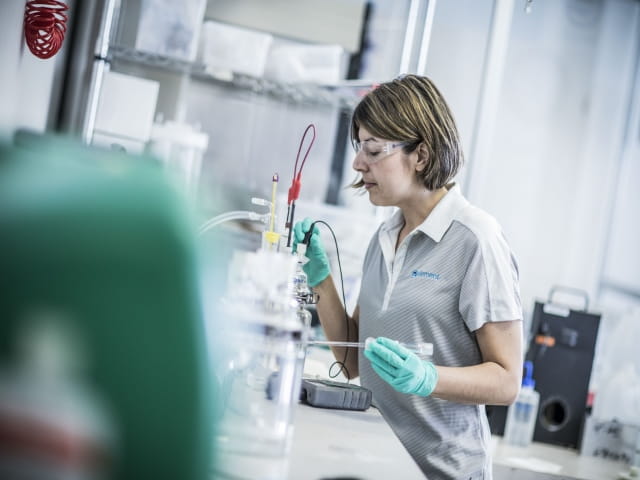Surgical and transcatheter heart valve replacement and repair devices require in vitro durability testing under accelerated conditions to mimic the in vivo lifetime use. Our cardiovascular device testing experts are ready to assist with the validation of your devices so that you can bring safe and effective products to patients worldwide.
Degenerative heart disease, calcification, congenital abnormalities, and infections are some of the causes of heart valve disease. Aortic and mitral valves may become stenotic or regurgitant, requiring replacement or repair. Transcatheter valve replacement or repair has been gaining traction replacing some surgical procedures with implants typically delivered either through percutaneous transfemoral or transapical access.
元素routinely characterizes heart valve prostheses using test methods tailored to the devices and their design. Applicable standards include ISO 5840, ISO 5910, ISO 7198, ISO 25539-1 and ASTM F2477.
心脏瓣膜耐久性试验
通过机械疲劳复制体内条件,对经导管心脏瓣膜进行体外耐久性测试,是植入物表征的关键步骤。我们在加速条件下,模拟植入后10至15年的生理应变,评估全套装置和支架支撑结构。
Ourtranscatheter mitral valve axial fatigue testingarticle discusses the test protocol used for heart valve repair device components.
支架支柱疲劳试验(S-N曲线生成)
In the case of stented valves, the stent portion of the device is often tested separately. Stent strut fatigue evaluates the high-strain portion of the stent or valve support structure. The test specimen may be either a representative geometry such as a stent coupon, or stent segments harvested from a post-processed device. Test specimen geometry is typically determined using finite element analysis.
To perform the test, our experts place a strut apex or other representative geometry on an axial fatigue tester using special fixturing to apply cyclic tension/compression. We can customize the test fixture to accommodate the specimen geometry, and typically 12 to 15 samples are tested simultaneously.
Additionally, we perform load monitoring to help detect specimen failures and ensure that the specimen reaches the desired load throughout the test. This data is then used to generate SN curves (stress vs. number of cycles).
心脏瓣膜架疲劳
许多生物瓣膜设计包括一个支持框架,以促进植入。框架通常是激光切割镍钛合金,编织线,或最近由生物可吸收聚合物制成。我们对这些瓣膜的支架进行了400米或600米周期的脉动疲劳载荷评估。
测试方法部署the stent inside a mock vessel with physiologically-relevant compliance and hydrodynamic pressure. It is important to ensure that the mock vessel geometry follows the stent design for proper apposition and fatigue loading.
在心脏瓣膜框架试验中,通常使用生理相关血管来确定给定装置的目标应变,然后使用厚壁血管进行疲劳试验。厚壁模拟血管使我们能够以更高的频率运行支架移植测试仪,从而减少了总的测试时间。
To learn more about this test method, read ourstent pulsatile durability testingarticle.
Device acceptance & failure criteria
制造商通常定义设备故障或验收的标准。失败的标准可能包括支架支撑试验的连续性丧失,或在全装置试验期间或结束时,在放大30倍时可见的任何断裂或破裂的支撑。在测试之后,设备制造商根据他们预先确定的标准检查样本。
元素uses ElectroForce 3200 and 3300 test instruments for stent strut fatigue tests coupled with several inspection methods including:
- 视觉
- 内窥镜
- High-speed video
- Strobe light
For more information about our heart valve device testing services, or to request a quote,联系我们的专家today.
making certain for nearly 190 years
更多来自元素

Transcatheter Mitral Valve Axial Fatigue Testing
虽然脉动耐久性试验通常是人们想到的主要试验,但阀门维修部件的轴向疲劳试验是表征单个装置耐久性的非常有用的工具。
Read More

Stroboscope Visual Inspection of Medical Devices
数字频闪仪有助于对心血管医疗设备进行加速疲劳的视觉检查。频闪灯在检测设备故障和跟踪测试过程中的运动方面是非常有用的工具。
Read More

Stent & Graft Testing
元素’s cardiovascular device experts offer a comprehensive suite of stent and graft testing including pulsatile durability, fatigue, visual inspection, and custom test methods.
Read More

Electrochemical Corrosion Testing
Element根据ASTM F2129进行电化学腐蚀测试,以确保医疗设备安全,并为患者提供预期益处。
services
Our Medical Device Testing Services




